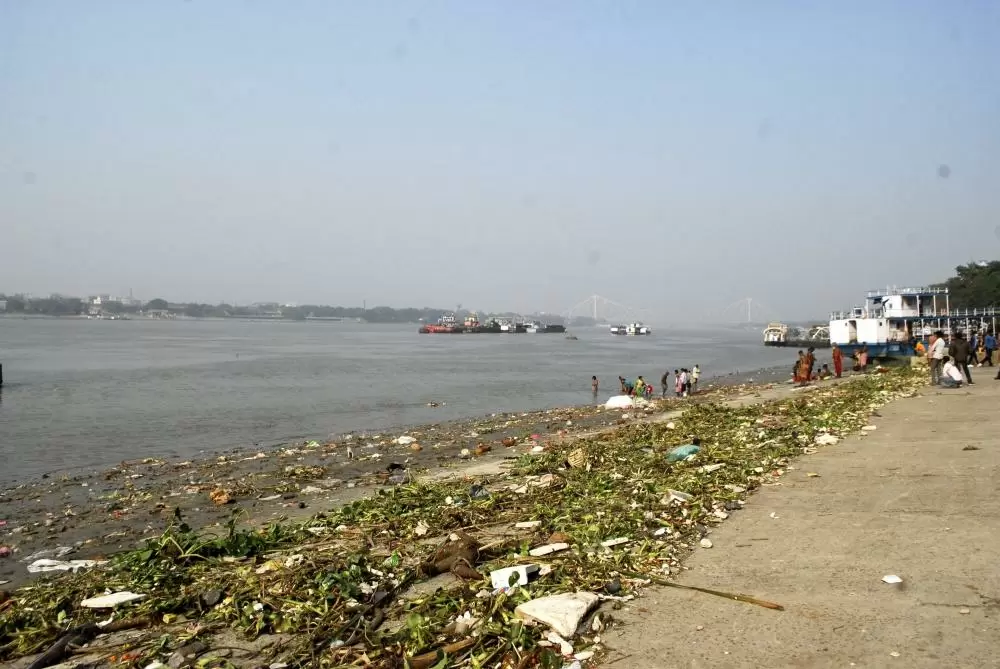River Ganga could send 3 bn microplastics a day into Bay of Bengal
Kolkata
22-January-2021

With the combined flows of the Brahmaputra and Meghna rivers, the Ganga river could be responsible for up to 3 billion microplastic particles entering the Bay of Bengal every day, according to new research by an international team of scientists.
Ganga rises in the Himalayas and runs through India and Bangladesh, where it joins the Brahmaputra and Meghna rivers shortly before reaching the Indian Ocean.
The combined flows of the three rivers are the largest in South Asia and form the most populous basin in the world, with over 655 million inhabitants relying on the water it provides.
The study was conducted using samples collected by an international team of scientists as part of the National Geographic Society's 'Sea to Source: Ganges expedition'.
"Globally, it has been estimated that 60 billion pieces of plastic are discharged into the ocean from rivers worldwide each day. However, what has been lacking until now has been a detailed analysis of how microplastic concentrations vary along a river's course," said the study's lead author Imogen Napper from the University of Plymouth in Britain.
Over two expeditions in 2019, 120 samples -- 60 each in pre and post-monsoon conditions -- were gathered from 10 sites by pumping river water through a mesh filter to capture any particles.
Watch This TWL Video
The samples were then analysed in laboratories at the University of Plymouth with microplastics found in 43 of the samples taken pre-monsoon, and 37 post-monsoon.
More than 90 per cent of the microplastics found were fibres and, among them, rayon and acrylic -- both of which are commonly used in clothing -- were the most abundant, said the study published in the journal 'Environmental Pollution'.
Combining the predicted microplastic concentration at the mouth of the river with the discharge of the river, scientists estimate that between one billion and three billion microplastics might be being released from the Ganges Brahmaputra Meghna River Basin every day.
The research was led by researchers from the University of Plymouth's International Marine Litter Research Unit, working with colleagues from the Wildlife Institute of India, University of Dhaka, WildTeam, University of Exeter, National Geographic Society and the Zoological Society of London.
The samples were collected during pre-monsoon (May to June 2019) and post-monsoon (October to December 2019), at sites ranging from Harsil closest to the source of the Ganga to Bhola in southern Bangladesh where it meets the Bay of Bengal.
The sample sites were selected to ensure a mixture of rural, urban, agricultural, tourism and religious locations, with the highest concentrations found closer to the river's mouth at Bhola in Bangladesh.
"We know that rivers are a substantial source of microplastics in the ocean. But the information like this can help identify the key sources and pathways of microplastic and hence inform management interventions," said one of the study's co-authors, Richard Thompson, Head of the International Marine Litter Research Unit at the University of Plymouth.
"With this type of evidence, we can progress toward using plastics more responsibly so as to get the many benefits they can bring without unnecessary contamination of the environment," Thompson said. - IANS
More Headlines
Bajrang Dal Appeals to Ban Oyo Check-Ins for Unmarried Couples in Bengaluru
Heavy Rains Predicted In Five TN Districts On January 11
Cold Wave Grips Rajasthan: Fatehpur Hits 1.1°C, Nagaur 1.7°C
Actor Ajith Kumar Escapes Unharmed After Crash During 24H Dubai Practice
32 Dead As 7.1 Magnitude Earthquake Strikes Nepal-Tibet Border
Bajrang Dal Appeals to Ban Oyo Check-Ins for Unmarried Couples in Bengaluru
Heavy Rains Predicted In Five TN Districts On January 11
Cold Wave Grips Rajasthan: Fatehpur Hits 1.1°C, Nagaur 1.7°C
Actor Ajith Kumar Escapes Unharmed After Crash During 24H Dubai Practice
32 Dead As 7.1 Magnitude Earthquake Strikes Nepal-Tibet Border










